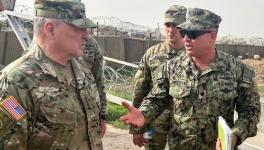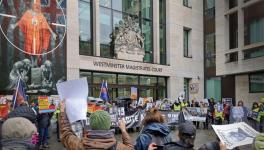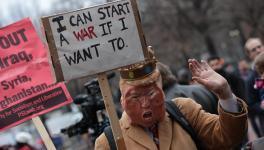Resistance To US Military Bases Expansion On The Japanese Island Of Okinawa Continues
Jinshiro Motoyama, who represents a civil group in Okinawa Prefecture that has pushed efforts to realize a referendum on a contentious U.S. base relocation plan, launches a hunger strike on Tuesday. | (Photo: ASAHI FUKUHARA)
Despite opposition from residents and the local government to the US plan to construct a new military base in the Japanese island of Okinawa, the central government of Japan has proceeded with the construction.
On January 28, construction of a 135 metres long seawall began on one side of the planned construction site on the Henoko bay on the island’s west coast. By springtime this year, the government also plans to construct another 515 metre long seawall next to the one currently under construction.
Once erected, the two walls will be used as piers for ships carrying landfill which will be dumped into the bay over an area 157 hectares, which will then be used as a foundation to construct an offshore airbase with two 5,000 metre long runways, which will be used to store and operate F-35 fighter jets and V-22 tiltrotor aircraft.
Residents of the island have been engaged in a relentless decades-long struggle to stop the new base from being raised, repeatedly gathering at the construction site to obstruct the activity, facing arrests and forcible evictions.
One such recent actions was on January 15, when protesters, holding placards calling for the US marines to be removed from the island, attempted to block the trucks carrying rock and mud to landfill the bay. Though the protests had remained peaceful, police forcibly carried away many demonstrators.
Holding placards that read “Okinawans will not give up”, last month, when rainfall battered the island as a typhoon was approaching it, about 70,000 Okinawans participated in a rally held in the capital city of Naha, chanting slogans vowing to stop the construction of the new base.
The construction will enormously damage the environmentally sensitive location. “Over 5,800 species of creatures, including 262 endangered species, are confirmed to exist in the waters of Henoko and Oura Bay. The number of species there exceeds the number in the World Natural Heritage sites in Japan.. [A]s many as about 1,300 species are unidentified, many of which are highly likely to be new species. It runs against the international trend of biodiversity conservation that the Japanese government moves ahead with the construction of a new base without doing academic surveys or without taking any protective measures,” one of Okinawa local government’s websitesstates. Fisheries will be severely affected as well.
Once the construction is complete, the plan is to relocate the Futenma base, which is currently located in the city of Ginowa, 9 kilometres to the northeast of the prefecture’s capital city of Naha and about 50 kilometres to the southwest of the new construction site.
This base, hosting about 3,000 US marines, was established after the US defeated the Japanese army in the Battle of Okinawa, which ended on June 22, 1945. “7.5 million howitzer rounds, over 60,000 naval shells, 20,000 rockets, and almost 400,000 hand grenades” were used by the US against this island, killing almost a quarter of its inhabitants and damaging nearly every structure built over it. The civilian death toll in this battle was higher than that in the nuclear bombing of Hiroshima and Nagasaki less two months later.
A brief history of Okinawa under American occupation
After the end of the second world war, the US had occupied the island until 1972. With the success of the communist revolution in China in 1949, the US revamped its base construction on this island, which is about 800 kilometres from Shanghai. The following year, when the Korean war broke out, the construction was sped up further and the existing bases were widely used to support air force missions in North Korea, where 20-30% of the population was wiped out and virtually all cities were to razed to the ground.
During the Vietnam war, Okinawa, more than 2,000 kilometres from Vietnam, was turned into a forward staging post, via which Agent Orange, among other things, was transported for use in the war. Deformities among Vietnamese children whose parental ancestors were exposed to the chemical continue till date.
One US army truck driver, who served in the island on the Naha port, described his work between 1965 and 1966 as follows: “We provided logistical support for the Republic of Vietnam war effort. Our mission was to unload large transport ships. Such items as 55 gallon drums of herbicides, oils, solvents and other materials. We handled the drums with (sic) loading and unloading, and often these drums leaked which contaminated our hands and clothing.”
Years later, in 2010, he was awarded a compensation for having developed lung cancer due to exposure. About 65 kilometres north of the Naha port where he was exposed to the chemical, is Camp Schwab, which is close to the location of construction of the new base. A huge amount of Agent Orange was stored at this camp to be transported to the forest area further to the north, where soldiers were trained in use of the chemical. Accounts of numerous US veterans corroborate this.
However, since US officially maintains that there was and is no presence of Agent Orange in Okinawa, a majority of the 132 compensation claims made by war veterans for diseases caused by exposure in this island have been rejected by the American government.
As recently as 2012, residents of the city of Nago, where most area of the camp is located, requested the Okinawa defense bureau to conduct dioxin test on Camp Schwab. They suspected that the deaths of a number of residents in that area after consuming shellfish was due to contamination of the water. The Bureau refused, citing that the testimonies of the US veterans had no credibility.
Apart from the threat of chemical exposure, lead poisoning due to firing drills, soil erosion and land degradation caused by activities in these bases has systematically affected the residents. Throughout the occupation, the number of US bases expanded, occupying a quarter of the island during the Vietnam war.
In order to make space for these bases, farmlands were forcibly acquired. This dispossessed many peasants of their means of livelihood and forced others to start farming on the hillside, which brought about permanent shifts in land use, food production, geography and economy of the island which became increasingly centred around the consumption needs of the personnel in the bases. The deep resentment against this often came to the fore in form of large protests when instances of rape, assaults and hit-and-run motor accidents by servicemen occurred repeatedly.
In the 60s, when a resistance movement emerged and strengthened throughout the decade, US first planned to secretly construct a new base in Henoko next to Camp Schwan, in order to overcome limitations of the Futenma base. At the peak of the Vietnam war, a US-based research company, commissioned by the government to help in the war, had compiled the original plan in a 260 page report.
This involved construction of an offshore base – equipped with one 3,000 kilometre long runway, a big military port and a bunker to store nuclear weapons – over an area of 550 hectares. The estimated cost of the project was USD 130 million, which, at that time, was about the size of the annual budget of the government of occupied Okinawa.
A similar plan, sent in form of a shorter report of 40 pages by the then chairman of the Joint Chiefs of Staff, Earle Wheeler, to then defense secretary, Robert Mcnamara, in July 1967 was approved, according to the now declassified documents. But the resistance on the ground by residents was strong by then. Acquiring land was no easy task. Also in Vietnam, the inevitable defeat of the US forces was becoming increasingly clear to the American government. As such, the plan was not put into action.
Almost half a century after Okinawa was returned to Japan, the struggle continues
As resistance continued, the US handed Okinawa back to Japanese control in 1972. However, that did not end the struggle of Okinawans. A total of 23 US military bases continue to occupy about 20% of Okinawa even today. Amounting to a mere 0.6% of Japan’s total land area, this small island, located more than 600 kilometres to the southwest of the mainland, still provides for 71% of the Japanese territory used by the US military, and houses about 60% of the total US military deployment in Japan. Including the military personnels and their dependents, the island hosts 50,000 – 55,000 Americans.
Residents continued to face assaults, rape and hit-and-run accidents by servicemen. Legal redress to victims was limited because the Japanese government maintained that as per “general international law”, personnels in foreign military bases cannot be subjected to the national laws. With that reasoning, the American servicemen were deemed to be out of the reach of the Japanese courts. It was only on January 11 that the foreign ministry removed this reasoning from its webpage, years after multiple academicians and government appointed committees, both in US and in Japan, pointed out nothing in the international law implied so.
The updated webpage now explains that in cases where US servicemen are accused of committing crimes during “performance of official duty”, the US military will have the “primary right to exercise jurisdiction over members of the United States armed forces or the [related] civilian component”.
In case of off-duty crimes, “Japan shall have the primary right to exercise jurisdiction”. However, Japanese government can choose “not to exercise jurisdiction”, in which case “it shall notify the [US] authorities.. as soon as practicable”. Whether the government will now act on future cases or choose “not to exercise jurisdiction” will be known soon for such incidents are not uncommon.
After one of the most disturbing of such incidents in 1995, when a 12-year old girl was kidnapped and raped by three servicemen from Camp Hensen, 85,000 outraged residents of the island came out in protest. The Japanese police demanded immediate custody of the accused, who were by then taken into custody by the US military.
The US did not comply. As per the agreement signed between the two countries in 1960, titled Status of Forces Agreement (SOFA), “The custody of an accused member of the United States armed forces or the civilian component over whom Japan is to exercise jurisdiction shall, if he is in the hands of the United States, remain with the United States until he is charged.”
This triggered the biggest anti-US demonstration on the island, demanding removal of US bases and scrapping of the agreement. As protests grew without relent, US finally agreed to hand over the accused, more than 25 days after taking them into custody early in September that year.
Referring to the crime a month later, the then commander of United States Pacific Command, Admiral Richard C. Macke, said at a press conference in October, “I think it was absolutely stupid. I have said several times: for the price they paid to rent the car [used to kidnap the child], they could have had a girl”.
This comment further outraged the residents of the island and their demand for removal of US bases grew louder. The very next year, US declared that the construction of new base was not permanently abandoned and announced its intention to construct the base on a landfill sunk into the Henoko bay.
Both Futenma base and the Camp Schwab were blockaded by Okinawan residents who took to streets en masse. Protests and sit-ins opposing the plan have continued to erupt time and again. After years of negotiation between the two governments, and numerous setbacks for the American plans, the Governor of the Okinawa prefecture, Hirokazu Nakaima, approved the construction in 2013.
The local government of Okinawa has been trying to resist the Japanese central government
The following year, Japanese congressman Denny Tamaki, along with the mayor of Nago, flew to the US to urge the then President Barack Obama to halt the construction. However, they could not meet the President. In 2014, the governor Takeshi Onaga, who had won the elections on anti-base platform, succeeded Nakaima and revoked the approval given by the previous governor. However, Onaga’s decision was declared illegal by the Supreme Court in December 2016.
Few months later, in April 2017, the central government started the construction work by building seawalls in the bay, inside which boulders and soil would be poured to raise a solid base of about 157 hectares off-shore. As soon as the work started, a large number of protesters gathered outside Camp Schwab.
After governor Onaga’s death in August last year, the Okinawa Prefecture yet again retracted the work approval by the end of that month, citing illegalities. Tamaki, who was one of the most vocal in demanding the removal of US bases, was elected as its governor next month. He received a significant majority over his opponent who was backed by the central government. In October, the central government requested the land ministry to invalidate the retraction of work approval by the Okinawa prefecture, which it promptly did. In December, work resumed again.
Urging the US government to stop the construction until the local residents voice their opinion through a referendum scheduled on February 24, one US citizen of Okinawan origin and a number activist groups staged a protest on January 11 this year and submitted a petition to the White House with almost two hundred thousand signatures.
The utter disregard shown by the Japanese government for the will of the residents and the local government seems to increasingly indicate that Japan, which had annexed the island in the late 1800s, is treating Okinawa as a colony which has been leased out to its ally, US.
The Tamaki-led Okinawan prefecture is continuing its efforts to resist, the latest act of which was on January 17, when it denied the defense ministry’s local bureau the permission to transplant 40,000 coral reef colonies required for the construction.
Get the latest reports & analysis with people's perspective on Protests, movements & deep analytical videos, discussions of the current affairs in your Telegram app. Subscribe to NewsClick's Telegram channel & get Real-Time updates on stories, as they get published on our website.
























